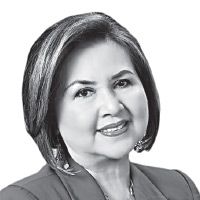Recipe for Singapore’s economic miracle – governance and education

An economic miracle
The latest video biography of
My husband, Max, and I saw
Steered by business Mandarins perched in glass skyscrapers, the economic fortunes of this diminutive nation are legendary. The island with no natural resources or agriculture has transformed itself in under 25 years from an “Oriental bazaar” into a fully industrialized nation.
Recipe for boom time
What was the recipe for this miraculous growth? Economic analysts have pointed to the stereotypical traits of the Chinese, who make up 78% of the population: a will to succeed; a sense of community; a respect for authority; and, an undeniable gift for business.
Plenty of other factors contributed to the relentless course, and these were carefully engineered by the PAP: limited labor union power and tough legislation against strikes; strict wage controls; open doors to foreign investments; absence of import and export duties; targeted industrial development; and long-term economic planning – all under the watchful eye of the Monetary Authority of Singapore (MAS), a powerful financial market regulator.
Much influenced by the Japanese model,
Return to UNESCO
In the ’80s before the economic
I decided to do our CLLSD consultation while attending the launch together with other UNESCO ASEAN Secretary Generals as guests. The grand celebration held at the
Unlike the Philippine NatCom, which is attached to the Department of Foreign Affairs, and has 45 experts headed by five committee chairpersons of Education, Communication, Culture, Social & Human Sciences, and Science & Technology, the new Singapore NatCom is linked to the Ministry of Education (MoE). The Singapore NatCom Chair is Dr. Ng Eng Hen (Minister for Education and Second Minister for Defence), while their Secretary General is Ms. Lim Wan Yong (Director of Planning, MoE). It has three sub-commissions: Education chaired by Ms. Chang Hwee Nee (Deputy Secretary for Policy, MoE); Science chaired by Prof. Leo Tan (Professor of Natural Sciences, NIE); while Culture and Information is chaired by Mr. Lock Wai Han (Deputy Secretary, Ministry of Information, Communication and the Arts).
The
The Singapore NatCom arranged two “learning journeys” for the ASEAN delegates: The first was to the National Institute of Education (NIE) and the second to the Institute of Technical Education (ITE) College East. The former is a complex of half a dozen huge buildings engaged throughout the year, holding three-month short courses to advance teacher specializations. I met a group of Math teachers whose full-time loads were reduced to give them this generous career development opportunity – FREE.
Here, we were welcomed by Director Lee Sing Kong, together with Asst. Prof. Lim Kam Ming (Sub Dean, Foundation Programmes Office) and Prof. Paul Teng (Dean, Graduate Programmes Office).
NIE, established in 1991, currently has 6,000 full time equivalent students and a staff of about 900 providing all levels of teacher education – FREE – ranging from initial teacher preparation programmes, inclusive of in-service programmes. Its six-month Leaders in Education Programme prepares senior education officers for principalship emphasizing the importance of innovation. Since 2007,
NIE’s Center for Research in Pedagogy and Practice was established in 2002 with funding from the MoE as the largest education research center in the Asia Pacific to develop new and innovative ways of teaching and learning. By 2007, its five-year strategic plan enhanced NIE’s global standing with the help of the International Alliance of Leading Education Institutes made up of seven world-leading education institutions.
ITE’s unique ‘Hands-On, Minds-On, and Hearts-On’ College Education
“Hands-On, Minds-On, and Hearts-On” is the institutional motto of ITE, according to Director & CEO Bruce Poh Geok Huat and Deputy Principal Dr. Ang Kiam Wee (Director, School of Applied & Health Sciences), who welcomed us to ITE, another complex of buildings several stories high encircling a central lobby.
Our group was amazed with the awesome facilities of their nursing course, IT and marketing programs, as well as the very popular beauticians’ training. The nurse aides use six $200,000 dummies that could blink and be teary-eyed. Its chest could be opened up to show the vital organs of the body, and register both the pulse and heart beat. The lectures are conducted using closed-circuit TV (CCT) and transmitted on huge “plasma” televisions. The
A global leader in vocational and technical education, ITE won the global IBM Innovations Award in Transforming Government, administered by
A post-secondary education institution, it was established under the MoE in 1992 to create opportunities for school leavers and adult learners to acquire skills, and knowledge for lifelong learning in a global economy. Besides full-time and part-time education, ITE also offers industry-based training, national-level Certification and Standards for industry to enhance the competitiveness of its workforce.
‘…Giving them a well-founded faith in the country’s future’
“…We cannot offer our next generation any fixed formula for success, or even any set goals in life. They will face new circumstances and problems. They will need to think through and work out their own solutions. But we must equip them with the basic attitudes, values and instinct, which make them Singaporeans.
“This is the common culture that will give them a shared perception of life, and draw them closer together as one people when confronted with serious problems. This will give them a well-founded faith in the country’s future. This is the DNA to be passed from one generation to the next.” (Deputy Prime Minister, now Prime Minister, Mr. Lee Hsien Loong – son of Lee Kuan Yew – speaking at the launch of National Education, 1997.)
(For more information or reaction, please e-mail at [email protected] or pss[email protected])
- Latest
- Trending

























